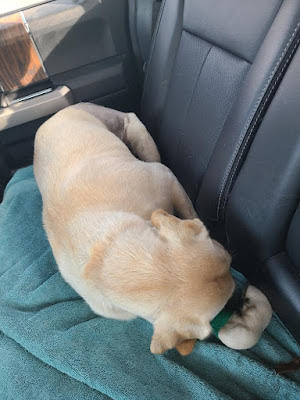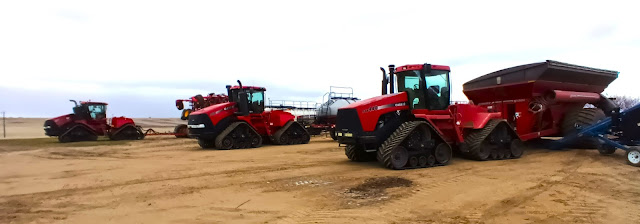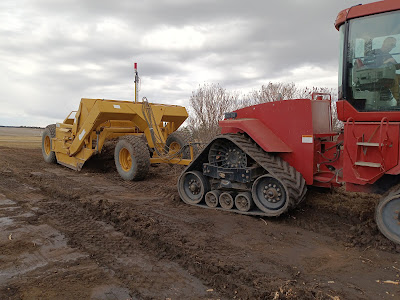The name of the game this week was planting, planting and more planting. Chris was out in the field every day this week except Friday and Saturday which ended up being rain days. They have 2,180 acres in the ground so far. 42% done! That is amazing considering we did not get in the fields until May 1st last year. This year we were a full 10 days earlier.
Farmer Bob got in on the action as well, planting a little over 300 acres in a field that the big seeder cannot make it into.
A typical day starts at 6-6:30 with breakfast and a Mountain Dew. I know, I know, but I have never been a coffee drinker, so I get my caffeine from a can. The main course for breakfast consisted of donuts! Nothing like shocking the system awake with that combination!
Actually, only two days started with donuts as Farmer was nice enough to buy a dozen for us boys.
Once breakfast is done and my body thoroughly shocked awake it is time to work. Usually getting things ready for Chris to hit the field. Fueling the tractors, loading semis with seed and fertilizer out of a bin which are then loaded into the seeder. We'll load him 2-3 times in the field throughout the day and then drop off another truck around 10pm which he fills by himself sometime in the middle of the night while we are all sleeping. Chris is a beast seeding for 20 hours most days, he did 33 hours straight with only an hour of sleep just before it started to rain. When the weather cooperates, you need to get the seed in the ground!
.jpg) |
| Loading Chris |
.jpg) |
| Loading Bob |
Prior to season, they develop a crop plan for the year detailing what is going into each of their fields. And when making a crop plan, you cannot just throw whatever into any field. The crop in each field is determined by what was in that field the year before as each crop takes and leaves certain nutrients and bacteria in the soil so the next crop must compliment the previous one. For example, you never put peas in one year and again the next year as they will almost certainly be prone to a disease. In fact, some people will wait 4 years before putting peas back into a field again.
Each of their fields are outlined in yellow on this map. To give you an idea of size, each of one the squares on the map is a section, which is a square mile, 640 acres. As you can see, their property is not all continuous. Rather it is scattered 14 miles east to west and 9 miles north to south. And not all land is considered equal. A section with a lot of potholes or sloughs is worth a lot less to a farmer than property that consists of all tillable acres.
So far, we have planted just peas and wheat, as those are the two hardiest varieties when it comes to the cooler, unpredictable spring weather. When it comes to wheat, two other things go into the ground beside the seed; urea and S10 fertilizer. The urea we use is a granular, which provide nitrogen to the plant through the soil and the S10 (or starter) is a phosphate fertilizer that provides sulfur to the plant throughout the growing season.
.jpg) |
| S10 in the foreground, urea in the back hopper |
Peas get just inoculant. Inoculant is actually a living microorganism which creates an infection in the plant creating nodes on the root that in turn ingests nitrogen from the air and provide it to the plant. The science that goes into planting is incredible.
Before each field is planted, they calculate how much seed they will need. There are several ways to do this such as pounds per acre. But you have to take into consideration the size, weight and seed count. There are other variables as well such as if it is drier or wetter than the previous year, as the slough sizes vary. Some years you can seed right through some wet spots, other years you have to go around them. Most of the time they hit is just right. Other times we need to run more seed out to finish the field. Bob was close on his calculations, but did call and say, "Bring me 3 buckets of seed". Here I am loading one of those buckets into his seeder.
While they were seeding, Ty, Dylan and I spent two days moving peas from one bin to another. We had 8 truckloads of peas to move at about one hour per truck. Why move peas from one bin to another? We needed to get them from a standalone bin to a bin that is attached to the automated treating facility.
.jpg) |
| The truck/tractor in the background is loading seed into bin#2 while the truck in the foreground is a customer picking up seed |
 |
| Same scene, different angle |
Chris's dad, Bob, arrived this week, needing hard work and a distraction from losing his brother Russ last week. He rolled for several days this week, spending hours upon hours in the tractor no doubt thinking about his brother and reflecting on life.
If you recall from previous year's posts, you need to roll the peas to push any rocks in the field down, so they do not get caught up in the combine come harvest season. Most other crops do not need to be rolled as they are not cut as close to the ground.
The big job of the week was Tuesday when we poured that concrete slab. 12 trucks, 120 yards of concrete. It actually was not that bad. We had 10 guys, and everyone had a job. Mine was edging and running the power screeder which was a new one for me. Here is a short video of some of the action.
We also had a pump truck which made life a lot easier, dumping it through the shoot. Well worth the extra $2,000 in expense. The concrete trucks pulls up to the back of the pump truck and dumps into a hopper. The pump truck operator them moves the boom around as needed.Now for the animals. Some of you may remember Nellie from last year. She is the one that got hit by a truck and had to have major surgery. This is what she looked like last September.
Living her best life, running and swimming in the sloughs. What a muddy mess!
Speaking of lab lives, this is what Remy was up to this week.....
.jpg) |
| Someone was a bad dog! |
Then there is Me-aui. Named by the kids as she meows all the time and the fact that they went to Maui this year, so she got a combo name. She is usually sitting on my chair outside the camper or actually my camper steps. Then she meows and meows and meows. One night I had to put her outside as she was sooooo annoying.
On the photography front. I got some more waterfowl shots. The teal moved in this week. It was funny, one day there were none, the next dozens of little teal dotting the ponds. The other birds featured this week is the scaup, canvasback, teal, coot and fluffy little bufflehead. As you can see, it was windier than heck that day. So much so that you had to hang on to the rail on the seeders when you filled it for fear of getting blown off by a gust.
 |
| Scaup and bufflehead |
 |
| Drake Can and a female Scaup |
 |
| Pair of Ruddy Ducks |
 |
| Coot and Blue-winged teal |

.jpg)



.jpg)
.jpg)
.jpg)
.jpg)
.jpg)


.jpg)
.jpg)





.jpg)


































